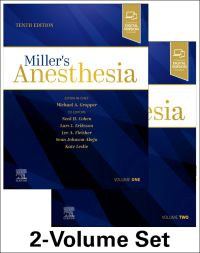ミラー麻酔学(第10版・全2巻)
Miller’s Anesthesia 10TH edition with online

Editors: Michael A. Gropper, Lars I. Eriksson, Lee A. Fleisher, Neal H. Cohen, Kate Leslie and Oluwaseun Johnson-Akeju
2024:10 2 vols. 3,016 p. 1,200 full color illus. ISBN 978-0-323-93592-0 (Elsevier) -US-
USD 482.99
Web販売価格:税込¥73,184 / 標準価格:税込¥97,757
*2024年9月25日時点の価格です。実際の価格は、為替レートや出版社の都合により変動いたしますので、最新の価格は以下オンラインストアリンクをご参照ください。
*Web販売価格は、紀伊國屋書店BookWeb Proでご注文され、付帯作業を伴わない納品を行い、弊社標準書式による請求書を発行し遅滞なくお支払いただく場合、あるいは、クレジットカードでお支払いいただく場合に適用される販売価格です。
概要
ミラー麻酔学は、この複雑な研究分野において専門医や学生に最も信頼されているレファレンスでありテキストです。第10版は、免疫系と救急医療についての新たな章を含み、持続可能性、グローバル保健の公平性、新型コロナウイルスを含む感染症などの重要な分野における新たな進展に対応します。
また、1200枚以上のカラー図版とともに、麻酔の実施と患者の安全に関するガイドライン、新しい技術、患者管理の段階的な解説、小児患者特有のニーズなど麻酔薬の最新情報を視覚的にわかりやすく示します。
価格照会・ご購入
- 紀伊國屋書店でご購入(一般の方向け):紀伊國屋書店ウェブストア
- 紀伊國屋書店でご購入(法人の方向け):紀伊國屋書店BookWeb Pro
※本件についてのお問い合わせ、お見積りについては最寄りの紀伊國屋書店営業所もしくはこちらまでお願いいたします。
収録明細
Section I. INTRODUCTION
1. The Scope of Modern Anesthetic Practice
Introduction
Forces Impacting Anesthesia Practice (Fig. 1.1)
Research and the Future of the Science of Anesthesia Practice
Conclusions
2. Anesthesia and Global Health Equity
Introduction
Section 1: Anesthesia and “Global Health Equity”
Section 2: Evolution of Anesthesia Care Models and Challenges Around the World
Section 3: Essentials for Practice in Resource-Variable Settings
Conclusions
Appendix 2.1. Links and Useful Resources
3. Perioperative Medicine
Introduction
The Anesthesiologist and Perioperative Medicine
Perioperative Management
Models of Perioperative Care
Artificial Intelligence and Perioperative Medicine
Perioperative Precision Medicine
Conclusion
4. Informatics in Perioperative Medicine
Introduction
Computer Systems
Computer Networks
The Internet
Information Security
Standards for Health Care Data Exchange
Regulation of Electronic Data Exchange
Requirements for Electronic Documentation
The Nature of Health Care Information in the Anesthesia Encounter
Development and Deployment of Anesthesia Information Management Systems
Requirements for Electronic Documentation of Anesthesia Care
Advantages of Implementation of Electronic Documentation in Anesthesia Care
Integration of Anesthesia Care Information with Operating Room Information Systems
Integration of Anesthesia Care Information with the Wider Health Record
Development of Decision Support Tools
Billing System Interactions
Challenges in Anesthesia Information Management System Implementation
Secondary Use of EHR Data
Operational Analytics
Analyzing Large Datasets
Interactions of Electronic Devices with the Delivery of Anesthesia Care
Conclusion
5. Quality Improvement in Anesthesia Practice and Patient Safety
Introduction
What Is Quality?
Quality Improvement (QI)
Challenges and Barriers to Quality Improvement Projects
Related Concepts: Improvement Science and Implementation Science
The Future: Research, Education, and Ethics
Summary
6. Human Behavior and Simulation in Anesthesia
Introduction
Human Factors
Heuristics, or Rules of Thumb
Strategies to Overcome Inherent Biases
High-Reliability Organizations
Simulation
Crisis Resource Management
7. Ethical Aspects of Anesthesia Care
Introduction
Ethical Theory
Common Ethical Issues Confronting Anesthesiologists
Ethics of Anesthesia Involving Pregnant Patients
Truth Telling – Disclosure of Errors and Apology
Advance Directives and Surrogate Decision Makers
Research Ethics
Physician Participation in Executions
Moral Integrity – Can the Physician be a Conscientious Objector in Medicine?
Section II. Anesthetic Physiology
8. Consciousness, Memory, and Anesthesia
Introduction
Consciousness
Memory
Organization and Function of Normal Memory
Effects of Anesthetic Drugs on Declarative Memory Function in Humans
Nonhuman Studies of Anesthetic Effects on Memory Processes and Behavior in the Medial Temporal Lobe
Human and Nonhuman Studies of Anesthetic Effects on Fear Memory Systems
Anesthetic Effects on Implicit Memory Function
9. Sleep Medicine
Physiology of Normal Sleep
Neuroanatomy of Sleep
How to Assess Sleep
Sleep and Breathing
Sleep and Anesthesia: Two Unequal Twins Influencing Perioperative Medicine
Sleep and Sedation in the Intensive Care Unit
10. Cerebral Physiology and the Effects of Anesthetic Drugs
Anatomy of the Cerebral Circulation
Effects of Anesthetics on Cerebral Blood Flow and Cerebral Metabolic Rate
Other Effects of Anesthetics on Cerebral Physiology
Cerebral Physiology in Pathologic States
11. Neuromuscular Physiology and Pharmacology
Neuromuscular Transmission
Neuromuscular Junction
Drug Effects on Postjunctional Receptors
Biology of Prejunctional and Postjunctional Nicotinic ACh Receptors
Neuromuscular Junction at Extremes of Age
12. Respiratory Physiology and Pathophysiology
Respiratory Physiology is Central in the Practice of Anesthesia
Ventilation
Diffusion of Gas
Lung Perfusion and V˙/Q˙ Match
Respiratory Gas Transport
Mechanics and Lung Volumes
Control of Breathing
Mechanisms of Hypoxemia and Hypercapnia
Lung Function Tests
Effect of Anesthesia on Respiratory Physiology
Mechanical Ventilation During Anesthesia
Postoperative Respiratory Complications
13. Cardiac Physiology
Physiology of the Intact Heart
Cellular Cardiac Physiology
Control of Cardiac Function
14. Gastrointestinal and Hepatic Physiology, Pathophysiology, and Anesthetic Considerations
Anatomy of the Gastrointestinal and Hepatic Systems
Gastrointestinal and Hepatic Physiology
Assessment of the Gastrointestinal and Hepatic Systems
Pathophysiology of the Gastrointestinal and Hepatic Systems
Anesthetic Considerations of Gastrointestinal and Hepatic Systems in Health and Disease
15. Renal Anatomy, Physiology, Pharmacology, and Evaluation of Function
Introduction
Organization of the Kidney
Induced Hypotension
16. Basic Principles of Pharmacology
Introduction
Fundamental Pharmacokinetic Concepts
Pharmacokinetic Models
Special Issues in Anesthetic Pharmacokinetics
Pharmacodynamic Principles
Special Populations
Summary
17. Inhaled Anesthetics: Mechanisms of Action
History
Integrated Effects on Central Nervous System Function
Identification of Molecular Sites of Anesthetic Action
Cellular Mechanisms
Simple Circuits and Complex Networks
Research Strategies for the Future
Summary
18. Inhaled Anesthetic Uptake, Distribution, Metabolism, and Toxicity
Introduction
Uptake and Distribution of Inhaled Anesthetics
Synthesis of the Model and Inhaled Anesthetic Induction: PK/PD
Metabolism and Toxicity of Inhaled Anesthetics
19. Pulmonary Pharmacology of Inhaled Anesthetics
Introduction
Bronchomotor Tone
Mucociliary Function and Surfactant
Pulmonary Hemodynamics
Control of Respiration
Inhaled Anesthetics and Acute Lung Injury
Nonvolatile Inhaled Agents
Summary
20. Inhaled Anesthetic Delivery Systems
Standards and Guidelines for Anesthesia Workstations
Functional Anatomy of the Anesthesia Workstation
Checking Your Anesthesia Workstation
21. Intravenous Anesthetics
Introduction
Intravenous Anesthetic Agents
Summary
22. Opioids
Introduction
Pharmacology of Opioids
Neurophysiologic Effects of Opioids
Respiratory Effects of Opioids
Cardiovascular Effects of Opioids
Endocrinologic Effects of Opioids and Stress Responses
Effects of Opioids on Digestive Organs
Other Opioid Effects
Pharmacokinetics and Pharmacodynamics of Opioids
Anesthetic Techniques Using Opioids
Other Opioid Agonists
Agonist–Antagonist Opioid Compounds
Opioid Antagonists
Drug Interactions with Opioids
23. Intravenous Drug Delivery Systems
Introduction
Pharmacokinetic Considerations
Pharmacodynamic Considerations
Designing Dosing Regimens
Intravenous Infusion Devices and Technologies
Future Perspectives
24. Pharmacology of Neuromuscular Blocking Drugs and Antagonists (Reversal Agents)
History and Clinical Use of Neuromuscular Blocking Agents
Principles of Action of Neuromuscular Blocking Drugs at the Neuromuscular Junction
Pharmacology of Succinylcholine
Nondepolarizing Neuromuscular Blocking Drugs
Reversal (Antagonism) of Neuromuscular Block
Current Antagonism Practice
Drugs Used to Antagonize (Reverse) Neuromuscular Block
25. Local Anesthetics
Basic Pharmacology
Anatomy of the Peripheral Nerve
Mechanism of Action of Local Anesthetics (Pharmacodynamics)
Clinical Pharmacology
Choice of Local Anesthetic for Various Regional Anesthetic Procedures
Pharmacokinetics
Toxicity
Development of Prolonged-Duration and Sensory- or Nociceptive-Selective Local Anesthetics
Biologic Mechanisms of Local Anesthetic Failure: Inflammation, Hyperalgesia, Tachyphylaxis, and Genetic Variants
26. Immune Implications of Anesthesia Care and Practice
Introduction
The Premise
Historical Context
Experimental Approaches Taken
Literature Review
Refining the Questions27–30
Other Patient Factors Influencing the Immune System in Perioperative Medicine
Artificial Intelligence, Machine Learning, and Precision Medicine Approaches
Current Limitations and Future Directions
Final Thoughts and Considerations
Section III. Anesthesia Management
27. Risk of Anesthesia
Introduction
Framework of Perioperative Risk
Issues Related to Study Design
Risks Related to Patient Characteristics
Special Patient Groups
Risks Directly Related to the Anesthetic Drug
Risks Related to Surgery
Risks Related to the Location of Surgery and Postoperative Monitoring
Risks Related to the Anesthesia Provider
Improving Anesthesia Safety
Summary
Acknowledgments
28. Preoperative Evaluation
Evolution of Pre-Anesthesia Evaluation
Goals and Benefits of Pre-Anesthesia Evaluation
Clinical Examination During Preoperative Evaluation
Frailty, Geriatric Conditions, and the Older Surgical Patient
Preoperative Evaluation of Patients with Coexisting Disease
Preoperative Laboratory and Diagnostic Studies
Preoperative Risk Assessment
Preoperative Medication Management
Planning for Anesthesia
Regulatory Issues
Preoperative Evaluation Clinic
Conclusion
29. Anesthetic Implications of Concurrent Diseases
Introduction
Cardiovascular Disease
Pulmonary Disease
Renal Disease
Hepatobiliary Disease
Neurologic and Neuromuscular
Endocrine and Metabolic
Rheumatic and Connective Tissue Diseases
Infectious Diseases
Genetic Diseases
Toxic Ingestions and Drug Abuse
Allergy and Anaphylaxis
Hematologic Disorders
30. Patient Positioning and Associated Risks
Introduction
Physiologic Considerations of Positioning
General Positioning Considerations
Specific Positions
Peripheral Nerve Injury
Pressure Injuries
Bite Injuries
Anesthesia Outside the Operating Room
Perioperative Visual Loss (POVL)
Conclusion
Disclosure
31. Neuromuscular Disorders and Other Genetic Disorders
Malignant Hyperthermia
Mh-Associated Syndromes/Pathological Conditions
Other Neuromuscular Disorders
Endocrine and Metabolic Myopathies
Mitochondrial Diseases and Mitochondrial Myopathies
Periodic Paralyses
Acquired Neuromuscular Diseases
Summary
32. Cardiovascular Monitoring
Heart Rate and Pulse Rate Monitoring
Electrocardiography (ECG) Monitoring
Blood Pressure Monitoring
Central Venous Pressure Monitoring
Pulmonary Artery Catheter Monitoring
Cardiac Output Monitoring
33. Perioperative Echocardiography and Point-of-Care Ultrasound (POCUS)
Introduction
History of Perioperative Echocardiography
Principles of Ultrasound
Ultrasound Modalities
Three-Dimensional Image Acquisition
Indications and Practice Guidelines
Transesophageal Echocardiography Examination
Epicardial and Epiaortic Imaging
Transthoracic Echocardiography Examination
Qualitative Assessment of the Heart
Quantitative Assessment
Hemodynamic Failure and Shock
Intraoperative Transesophageal Echocardiography – Noncardiac Surgery
Intraoperative Transesophageal Echocardiography – Cardiac Surgery
Intraprocedural Transesophageal Echocardiography – Structural Heart Interventions
Emerging Technologies
Perioperative Transthoracic Echocardiography and Focused Cardiac Ultrasound (FoCUS)
Critical Care and Perioperative Care
Training and Certification
Future Directions
34. Implantable Cardiac Pulse Generators: Pacemakers and Cardioverter-Defibrillators
Introduction
Basic Cardiac Implantable Electronic Device Function
Perioperative Considerations
Conclusions
35. Neurophysiologic Monitoring
Monitoring Modalities
Clinical Applications of Neurophysiologic Monitoring
Nonsurgical Factors Influencing Monitoring Results
Anesthetic Optimization During Multimodality Neurophysiologic Monitoring
Summary
36. Monitoring the Brain’s Response to Anesthesia and Surgery
Why Should we Monitor the Brain During Anesthesia?
What Would we Like from an Ideal Monitor of Anesthetic Effect?
Consciousness Terminology
Clinical Signs in Anesthesia Monitoring
Electroencephalography
Epidemiology of Index-Based Monitoring
Clinical Outcome Research
Conclusions
37. Respiratory Monitoring
Overview of Respiratory Monitoring
The Physical Examination
Pulse Oximetry
Mixed Venous Oxygen Saturation
Tissue Oxygenation
Capnometry and Capnography
Blood Gas Analysis
Monitoring Lung Flows, Volumes, and Pressures
Plethysmographic Monitoring
Respiratory Rate Monitoring: Apnea Monitoring
Imaging for Respiratory Monitoring
Point-of-Care Tests
Respiratory Monitoring in Special Conditions
Automated Data Systems
Additional Monitored Variables
38. Renal Pathophysiology and Treatment for Perioperative Ischemia and Nephrotoxic Injury
Introduction and Acute Kidney Injury Definitions
Pathophysiologic Processes of Ischemic Acute Kidney Injury
Detection of Acute Kidney Injury
Preoperative Evaluation of Renal Function and Risk Stratification
Perioperative Acute Kidney Injury: Mechanisms and Treatment
Perioperative Blood Pressure and Fluid Management
Nephrotoxins and Acute Kidney Injury
Renal Replacement Therapy
Summary
39. Neuromuscular Monitoring
Principles of Peripheral Nerve Stimulation
Types of Peripheral Nerve Stimulation
Basic Considerations
Sites of Nerve Stimulation and Different Muscle Responses
Patterns of Nerve Stimulation
Equipment
Peripheral Nerve Stimulator
Objective Monitors
Evaluation of Recorded Evoked Responses
Use of Nerve Stimulators in Daily Clinical Practice
When to Use a Peripheral Nerve Stimulator
40. Airway Management in the Adult
Introduction
Algorithms for Management of the Difficult Airway
Functional Airway Anatomy
Airway Assessment
Physiologic Concepts for Airway Management
Anesthesia for Airway Management
Mask Ventilation
Supraglottic Airway
Tracheal Intubation
Emergency Invasive Airway Access
Extubation of the Trachea
Dissemination of Critical Airway Information
Summary
41. Spinal, Epidural, and Caudal Anesthesia
Principles
Practice
Historical Perspectives
Anatomy
Anatomic Variations
Mechanism of Action
Physiologic Effects
Indications
Contraindications
Spinal Anesthesia
Epidural Anesthesia
Combined Spinal–Epidural
Caudal Anesthesia
Complications
Outcomes
Recent Advances
42. Peripheral Nerve Blocks and Ultrasound Guidance for Regional Anesthesia
Introduction
Techniques for Localizing Neural Structures
Approaches to Regional Block with Ultrasound
Continuous Catheter Techniques
Training
Summary and Conclusions
43. Perioperative Fluid and Electrolyte Therapy
Physiology
Fluid Pharmacology
Clinical Fluid and Electrolyte Management
44. Perioperative Acid–Base Balance
Introduction – Why Is Acid–Base Balance Important?
What Are Acids and Bases?
What Determines the Acidity or Alkalinity of a Solution?
Acid–Base Abnormalities
Regulation of Acid–Base Balance
Analytic Tools Used in Acid–Base Chemistry
Acid–Base Problems in Perioperative and Critical Care Medicine
Treating Acid–Base Disturbances
Summary
45. Patient Blood Management: Transfusion Therapy
Evolution and Recent History of Blood Transfusion Therapy
Blood Procurement
Blood Component Therapy: Indications for Transfusion
Synthetic Oxygen-Carrying Substances
Autologous Blood
Compatibility Testing
Maximal Surgical Blood Order Schedule
Emergency Transfusion
Fresh Whole Blood
Complications
Citrate Intoxication and Hyperkalemia
Temperature
Acid–Base Abnormalities
Transfusion Reactions
Leukoreduction and Irradiation of Blood Transfusions
Informed Consent
46. Patient Blood Management: Coagulation
Introduction
Normal Hemostasis
Disorders of Hemostasis
Antithrombotics, Thrombolytics, and Procoagulant Drugs
Perioperative Management of Anticoagulation
Emergent Reversal of Anticoagulants
Conclusion
Acknowledgment
Section IV. Adult Subspecialty Management
47. Management of the Patient with Chronic Pain
Introduction
Drugs Used for Chronic Pain
Interventional Methods Used for Chronic Pain
Perioperative Management of Patients with Chronic Pain
Acknowledgments
48. Palliative Medicine
What Is Palliative Medicine?
Where Is Palliative Care Delivered?
Differences Between Hospice Care and Palliative Care
Anesthetic Concerns in the Patient Receiving Palliative Care
Communication
Prognosis
The Dying Process
49. Anesthesia for Thoracic Surgery
Introduction
Concomitant Medical Conditions
Difficult Endobronchial Intubation
Prediction of Desaturation During One-Lung Ventilation
Assessment for Repeat Thoracic Surgery
Intraoperative Monitoring
Invasive Hemodynamic Monitoring
Other Monitoring Technology
Indirect Cardiac Output
Lung Isolation
Difficult Airways and One-Lung Ventilation
Management of Lung Isolation for Thoracic Surgery and COVID-19 Patients
Lung-Isolation Techniques in Patients with a Tracheostomy in Place
Anesthetic Management
Management of One-Lung Ventilation
Hypoxic Pulmonary Vasoconstriction
Ventilation Strategies During OLV
Prediction of Hypoxemia During One-Lung Ventilation
Treatment of Hypoxemia During One-Lung Ventilation
Anesthetic Management for Common Surgical Procedures
Pulmonary Surgery
Lobectomy
Pneumonectomy
Limited Pulmonary Resections: Segmentectomy and Wedge Resection
Anesthetic Management for Specific Surgical Procedures
Anesthesia for Tracheal Resection
Blebs, Bullae, Cysts, and Pneumatoceles
Lung Transplantation
Pulmonary Hemorrhage
Pulmonary Thromboendarterectomy
Bronchopulmonary Lavage
Mediastinal Masses
Thymectomy for Myasthenia Gravis
Postoperative Management
Postoperative Analgesia
50. Anesthesia for Cardiac Surgical Procedures
Cardiovascular Disease in the 21st Century
Evaluation and Monitoring
Premedication
Induction of Anesthesia
The Pre–Cardiopulmonary Bypass Period
Onset of Cardiopulmonary Bypass
Weaning from Cardiopulmonary Bypass
Termination of Cardiopulmonary Bypass
Chest Closure
Transport to the Intensive Care Unit
The Post-Bypass Period: Common Problems After Cardiopulmonary Bypass
Management of Cardiopulmonary Bypass
Pathophysiology of Coronary Disease
On-Pump Coronary Artery Bypass Grafting Surgery
Off-Pump Coronary Artery Bypass Surgery
Minimally Invasive Coronary Artery Bypass Surgery
Total Endoscopic Coronary Artery Bypass
Hybrid Coronary Revascularization
Mitral Valve Disease
Aortic Valve Disease
Other Valvular Disease
Surgical Management of Heart Failure
Heart Failure
Congenital Heart Disease in Adults
Other Cardiac Procedures
51. Anesthesia for Correction of Cardiac Arrhythmias
Historical Perspectives
Scope of Cardiac Arrhythmias
Normal Cardiac Rhythm
Cardiac Arrhythmias
Permanent Pacing
Resynchronization Therapy
Implantable Cardioverter-Defibrillator
Correction of Cardiac Arrhythmias with Ablation Therapy
Leadless Pacemaker
Future Trends
52. Anesthesia for Vascular Surgery
Preoperative Evaluation
Abdominal Aortic Reconstruction
Thoracoabdominal Aortic Surgery
Endovascular Aortic Repair Surgery
Hybrid Arch Repairs
Carotid Endarterectomy
Endovascular Treatment of Carotid Disease: Carotid Artery Stenting
Lower Extremity Revascularization
53. Anesthesia for Neurologic Surgery and Neurointerventions
Recurrent Issues in Neuroanesthesia
Specific Procedures
54. Anesthesia for Bariatric Surgery
Obesity as a Disease
Nonsurgical Management of Obesity
Surgical Management of Obesity
Anesthetic Management of the Bariatric Surgical Patient
Metabolic and Bariatric Surgery Accreditation and Quality Improvement Program (MBSAQIP®)
Considerations for Management of the Obese Patient Presenting for Nonbariatric Surgery
55. Anesthesia and the Renal and Genitourinary Systems
Innervation of the Genitourinary System
Renal Blood Flow
Anesthesia for Patients with Renal Disease
Renal and Genitourinary Procedures
Postoperative Management of the Patient with Renal Disease
56. Anesthesia for Abdominal Organ Transplantation
Kidney Transplantation
Pancreas Transplantation
Liver Transplantation (LT)
Intestinal, Liver–Intestinal, and Multivisceral Transplant
Conclusion
57. Anesthesia for Organ Procurement
Introduction
Management of Organ Donors After Declaration of Brain Death (DBD)
Donation After Circulatory (Cardiac) Death (DCD)
Extended Criteria Donor
Management of Organ Donors Before Procurement
Management of Donors After Circulatory Death
Management of Organ Donor During Procurement Surgery
Management of Living Organ Donors
Organ Preservation and Management After Procurement
58. Anesthesia for Obstetrics
Physiologic Changes During Pregnancy and Delivery
Uteroplacental Physiology
Labor Progress
Labor Analgesia
Anesthesia Considerations for Operative Delivery
Anesthesia for Cesarean Delivery
Postcesarean Pain Control and Recovery
Complications of Regional Anesthesia
Maternal Comorbidities
Anesthesia for Malpresentation and External Cephalic Version
Obstetric Emergencies
Nonobstetric Surgery During Pregnancy
59. Anesthesia for Fetal Surgery and Other Fetal Therapies
Indications, Procedures, and Outcomes
Twin Reversed Arterial Perfusion Sequence
Preoperative Assessment and Counseling
Intraoperative Management and Considerations
Postoperative Management and Considerations
Management of Ex Utero Intrapartum Treatment (EXIT) Procedure
Conclusions and Future Considerations
60. Anesthesia for Orthopedic Surgery
Preoperative Evaluation
Special Considerations for Conditions Leading to Orthopedic Surgery
Orthopedic Procedures in Children with Special Conditions
Perioperative Management of the Orthopedic Patient
Anesthesia for Spine Surgery
61. Geriatric Anesthesia
Organ-Specific Age-Related Physiologic and Pathologic Changes
Preoperative Assessment of Older Surgical Patients
Intraoperative Management Considerations for Older Adults
Postoperative Concerns
Outcomes
62. Anesthesia for Trauma
Introduction
Prioritizing Trauma Care
Emergency Airway Management
Resuscitation from Hemorrhagic Shock
Trauma to the Central Nervous System
Orthopedic and Soft Tissue Trauma
Other Traumatic Injuries
Selected Patient Populations
Postoperative Care
Summary
63. Prehospital Care for Medical Emergencies and Trauma
Background
Basic Versus Advanced Life Support (And Beyond)
Emergency Medical Technician and Paramedic-Based Emergency Medical Service Systems
Primary Survey and Initial Assessment at the Scene
Out-of-Hospital Cardiac Arrest
Respiratory Distress
Neurologic Injury and Head Injury
Prehospital Trauma
Point-of-Care Diagnostics
Overdose/Toxicology/Environmental Exposure
Horizons in Prehospital Care
64. Biologic, Natural, and Human-Induced Disasters: The Role of the Anesthesiologist
Introduction
Section 1: Natural Disasters
Section 2: Acts of Terrorism
Section 3: Chemical, Biological, Radiologic, and Nuclear (CBRN) Warfare
Section 4: Epidemic and Pandemic Infectious Outbreaks
65. Anesthesia for Ophthalmic Surgery
Overview of Ophthalmic Anesthesia
Ophthalmic Procedures
Preoperative Evaluation
Orbital Blocks
Monitored Anesthesia Care
General Anesthesia
Anesthesia for Pediatric Ophthalmology
Postoperative Considerations in Ophthalmic Surgery
Anesthesia-Related Eye Injuries
Conclusion
66. Anesthesia for Otolaryngologic and Head–Neck Surgery
Synopsis of Ear, Nose, and Throat Anatomy
Preoperative Evaluation for Ear, Nose, and Throat Surgery
Airway Management in Otolaryngology
Airway Disorders in Otolaryngology
Anesthesia for Panendoscopy
Otolaryngologic Trauma
Nasal Surgery
Tonsillectomy and Adenoidectomy
Endoscopic Sinus Surgery
Thyroid and Parathyroid Surgery
Airway Fires
Ear Surgery
Parotid and Other Salivary Gland Surgery
Sleep Apnea Surgery
Zenker Diverticulum
Anesthesia for Surgical Airways: Cricothyrotomy and Tracheostomy
Neck Dissection and Laryngectomy
Maxillary, Mandibular, and Temporomandibular Joint Surgery
Ear, Nose, and Throat Laser Surgery
Phonosurgery
Head and Neck Flap Reconstructive Surgery
Stridor Management
Anesthesia for Face Transplantation
Conclusion
67. Anesthesia for Robotic Surgery
Introduction
Advantages of Robotic Surgery
Robotically Assisted Intubation
Anesthesia for Robotic Surgery: Urology, Gynecology, and Abdominal Surgery
Types of Robotic Surgery
Summary
68. Ambulatory (Outpatient) Anesthesia
Introduction
Benefits of Ambulatory Surgery
Facilities for Ambulatory Surgery
Patient Selection Criteria
Preoperative Assessment
Patient Preparation
Anesthetic Techniques
Monitoring Depth of Anesthesia
Recovery from Ambulatory Anesthesia
Postoperative Pain
Postoperative Nausea and Vomiting
Enhanced Recovery after Surgery (ERAS)
Special Areas
Home Readiness and Beyond
69. Non–Operating Room Anesthesia
Overview: Defining Non–Operating Room Anesthesia – What It Is and How We Got Here
Transitional Priorities for Anesthesiologists Outside of the Operating Room
Gastrointestinal Procedures in the Endoscopy Suite
Interventional Pulmonary Procedures
Novel Anesthetic Concerns
Anesthesiology for Image-Guided Interventions: Evolution of a New Interface
Diagnostic and Therapeutic Interventions: New Challenges
Procedures Guided by Computed Tomography, Positron Emission Tomography, and Magnetic Resonance Imaging
Image-Guided Procedures for Specialty Areas: Neuroradiology and Interventional Cardiology
Interventional Echocardiography Anesthesiologists as Co-Proceduralists
The Road Ahead: Toward a Comprehensive Strategy
70. Clinical Care in Extreme Environments:: Physiology at High Altitude and in Space
Introduction to Altitude and Explanation of Hypobaric Hypoxia and Its Effect on Physiologic Performance
Physiologic Responses to Hypoxia/Acclimatization
Altitude Illness
Special Situations at Altitude
Anesthesia at Altitude
Space Medicine
The Environmental Challenges Posed by Spaceflight
Cardiovascular Physiology During Spaceflight
Pulmonary Physiology During Spaceflight
Musculoskeletal Physiology During Spaceflight
Central Nervous System and Psychological Challenges During Spaceflight
The Effect of Spaceflight on Other Physiologic Systems (Including the Immune and Gastric Systems)
Potential Medical Scenarios During Manned Space Missions
Thoughts and Considerations for Anesthetic Provision in Space
71. Clinical Care in Extreme Environments:: High Pressure, Immersion, Drowning, Hypo-, and Hyperthermia
Introduction
Effects of Increased Gas Pressure
Hyperbaric Oxygen Therapy
Physiology of Immersion
Drowning
Hypothermia
Hyperthermia
Section V. Pediatric Anesthesia
72. Pediatric Anesthesia
Physiological Considerations
Pharmacology
Anesthetic Drugs
Anesthetic Management
Anesthetic Management for Specific Pediatric Conditions and Procedures
Conclusion
73. Anesthesia for Pediatric Cardiac Surgery
Unique Features of Pediatric Cardiac Anesthesia
Congenital Heart Disease
Anesthetic Management
Cardiopulmonary Bypass
Postoperative Management
Anesthesia for Heart and Lung Transplantation
Anesthesia for Closed-Heart Operations
Anesthesia for Cardiac Catheterization
Adult Congenital Heart Disease
Pediatric Cardiac Electrophysiology
Advances in Resynchronization Therapy
Anesthesia for Noncardiac Surgery
Offsite Anesthesia in Cardiac Surgery Patients
74. Regional Anesthesia in Children
Introduction
Indications, Contraindications, and Complications
Safety, Precautions, and Discharge Criteria
Relevant Differences Between Children and Adults
Pharmacology of Local Anesthetics and Additives
General Technique and Equipment Consideration
Specific Regional Techniques
75. Pediatric and Neonatal Critical Care
Relationship Between the Intensive Care Unit and the Operating Room
Family Partnered Care in the Pediatric Intensive Care Unit (PICU)
Disclosure of Medical Errors
Organization of the Pediatric Intensive Care Unit
Cardiovascular System
Common Cardiovascular Disease States
Cardiovascular Pharmacology
Disorders of Cardiac Rhythm
Hypertension
Neonatal Resuscitation
Phases of Resuscitation
Interventions During the Cardiac Arrest (No Flow) and Cardiopulmonary Resuscitation (Low Flow)
Postresuscitation Myocardial Dysfunction
Ventricular Fibrillation and Ventricular Tachycardia in Children
Respiratory System
Central Nervous System
Renal System
Endocrine System
Gastrointestinal System
Hematology
Oncology
Immunity and Infection
Pediatric Trauma
Section VI. Postoperative Care
76. The Postanesthesia Care Unit
Admission to the Postanesthesia Care Unit
The Standards for Postanesthesia Care
Early Postoperative Physiologic Changes
Transport to the Postanesthesia Care Unit
Upper Airway Obstruction
Management of Upper Airway Obstruction
Differential Diagnosis of Arterial Hypoxemia in the Postanesthesia Care Unit
Pulmonary Edema
Monitoring and Treatment of Hypoxemia
Oxygen Delivery Systems
Hemodynamic Instability
Myocardial Ischemia: Evaluation and Treatment
Cardiac Arrhythmias
Renal Dysfunction
Postoperative Hypothermia and Shivering
Postoperative Nausea and Vomiting
Delirium
Emergence Excitement
Delayed Awakening
Discharge Criteria
Infection Control
Postoperative Management of Patients Undergoing Transcatheter Aortic Valve Replacement and Transcatheter Mitral Valve Repair
Immediate Postoperative Care of Craniotomies
Potentially Devastating Visual Complications
Future Considerations
Summary
77. Acute Postoperative Pain
Fundamental Considerations
Systemic Analgesic Techniques
Regional Analgesic Techniques (see also Chapters 41 and 42Chapter 41Chapter 42)
Other Techniques
Postoperative Analgesia in Special Populations
Inpatient Pain Services
78. Perioperative Neurocognitive Disorders
Introduction
Clinical Overview
Nomenclature and Assessment of Perioperative Neurocognitive Disorders
Measurement and Diagnosis of Perioperative Neurocognitive Disorders
Risk Factors and Perioperative Management
Mechanisms of Perioperative Neurocognitive Disorders
What Should We Tell Patients about PNDs?
Future Directions
Section VII. Critical Care Medicine
79. Critical Care Anesthesiology
Introduction
Intensive Care Unit Structure and Management
Acute Respiratory Distress Syndrome and Lung-Protective Ventilation
Sepsis and Shock
Hemodynamic Resuscitation in Shock
Care for Patients Receiving Cancer Immunotherapy in the Intensive Care Unit
COVID-19 Pandemic
Point-of-Care Ultrasound in Critical Care
Cardiac Critical Care Medicine and Mechanical Circulatory Support
Conclusion
80. Neurocritical Care
Intracranial Physiology and Cerebrovascular Autoregulation
General Cardiopulmonary Considerations
Fluids, Electrolytes, Blood Glucose Concentration
Temperature Control
Monitoring
Common Diseases in the Neurocritical Care Unit
Postoperative Neurosurgical Care
Brain Death
Ethical Considerations
Conclusion
81. Extracorporeal Membrane Oxygenation and Cardiac Devices
Introduction
History of Extracorporeal Cardiorespiratory Support
ECMO for Respiratory Failure (VV ECMO)
Extracorporeal Membrane Oxygenation for Patients Awaiting and Undergoing Lung Transplantation
Emerging Infectious Diseases, Coronavirus Disease 2019 (COVID-19)
ECMO for Circulatory Failure (VA ECMO)
The Ethics of Extracorporeal Membrane Oxygenation
The Mechanics of Extracorporeal Membrane Oxygenation
Vascular Access for Extracorporeal Membrane Oxygenation
Monitoring on Extracorporeal Membrane Oxygenation
Anticoagulation
Therapeutic Monitoring of Unfractionated Heparin
Weaning from Extracorporeal Membrane Oxygenation
Complications of Extracorporeal Membrane Oxygenation
The Anesthesiologist’s Role in Extracorporeal Membrane Oxygenation
82. Cardiopulmonary Resuscitation and Advanced Cardiac Life Support
Sudden Cardiac Arrest and Cardiopulmonary Resuscitation
Recognition and Management of Specific Arrhythmias
Postresuscitation Interventions
Pediatric Resuscitation
Future of Resuscitation Science and Care
Section VIII. Ancillary Responsibilities and Problems
83. Burn Management
Introduction
Pathophysiology
Hemodynamic Alterations
Inhalation Injury
Acute Management
Estimation of Size and Depth of Burn Injury
Fluid Resuscitation
Electrical Injury
Chemical Burns
Cold Injury
Stevens–Johnson Syndrome/Toxic Epidermal Necrolysis
Special Considerations
Infection Control
Metabolic Considerations
Nutrition
Anesthetic Management
Postoperative Care
Pain Management
Conclusion
84. Occupational Safety, Infection Control, and Substance Use Disorders
Physical Exposures
Infectious Exposures
Substance Use Disorders
Fatigue
85. Emergency Preparedness in Health Care
Introduction
Background
The Scope of the Challenge to Society
The Special Challenge to Health Care
The Cascade Effect
Planning, Coordination, and Mitigation
CMS Emergency Preparedness Rule
86. Clinical Research
Introduction
Key Principles
Study Design
Study Protocol
Ethical and Regulatory Considerations
Study Management
Study Reporting
Reflection, Feedback, and Forward Planning
87. Interpreting the Medical Literature
Introduction
The Publication Process
Accessing the Medical Literature
Assessing the Methodology of a Study
Tools to Ensure Study Quality
Interpreting the Analysis of a Study
The Dark Side of the Medical Literature
Conclusions
Index
(学術洋書部)





